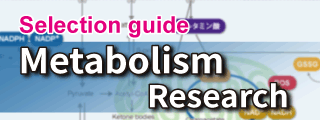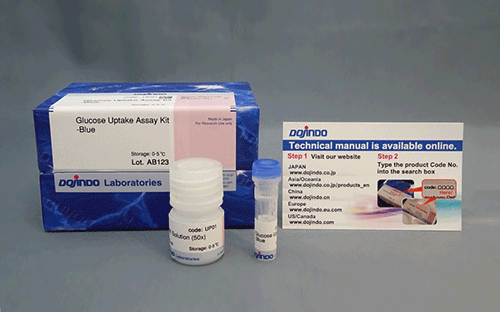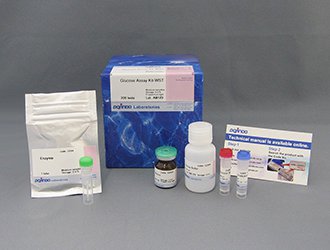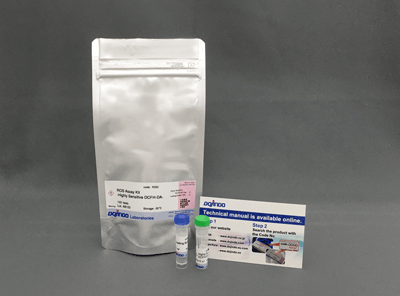Glucose Uptake Assay Kit-Red

- Cellular function
- Cellular senescence
- Cellular metabolism
- Fluorescent dye
- Fluorescence microscope
- FCM
Glucose Uptake Capacity Assay
- ・Highly sensitive and simple measurement of glucose uptake capacity
- ・Applicable for a plate reader & FCM
- ・Reduces dye leakage after staining
-
Product codeUP03 Glucose Uptake Assay Kit-Red
| Unit size | Price | Item Code |
|---|---|---|
| 1 set | $462.00 | UP03-10 |
General number of usable assays for 1 set
35 mm dish x 12 or 96-well microplate x 1
| 1 set | Glucose Uptake Probe-Red WI Solution (50×) |
×1 5 ml ×1 |
|---|
Description
Nutrient metabolism is necessary for energy production in cells and regulates various cellular functions, including gene expression. Glucose is one of the key substrates for the generation of ATP and sustaining cellular homeostasis. Thus, glucose metabolism has been the subject of intense investigations. In cancer research, tumor cells enhance glucose uptake and consumption for their growth and proliferation. Therefore, elevated glucose uptake is a marker of tumors, and glucose transporters are important targets in cancer treatment.
One standard method for evaluating the glucose uptake ability of cells uses radioisotope-labeled glucose. Although this method has been used for many years, it requires special handling facilities and disposal of radioactive materials. The enzyme cycling method using 2-deoxy-D-glucose, which enables colorimetric and fluorometric plate assays, cannot be applied to cell imaging and flow cytometry. Recently, 2-NBDG, a fluorescently labeled glucose analog, has been used widely to detect cellular glucose uptake by fluorescence imaging and flow cytometry1). However, the sensitivity of this method is poor because of the low fluorescence intensity of 2-NBDG.
To resolve these limitations, novel fluorescent probes, Glucose Uptake Probes, were developed. These probes emit strong fluorescence, allowing highly sensitive detection of cellular glucose uptake by fluorescence imaging, flow cytometry or microplate assay. The WI Solution in these kits enhances cellular retention of the probe to give more reliable data.

Manual
Technical info
Four Advantages Compare to Existing Method
Glucose Uptake Probe-Red allowing highly sensitive detection of cellular glucose uptake by fluorescence imaging or flow cytometry. The WI Solution in this kit can enhance cellular retention to provide more reliable experimental data. Also, compare with the existing method (2-NBDG), the measurement time can be significantly reduced.
①Multi-color Imaging
Glucose Uptake Probe can easily co-stain with other fluorescent reagents. The following image is a co-staining result with Glucose Uptake Probe-Red and Lipid Droplets (Green: Lipi-Green, Code LD02) in adipocytes differentiated 3T3-L1 cells.


Cell line: 3T3-L1
Imaging Conditions
Glucose Uptake Probe-Red: Ex=533-557 nm, Em=570-640 nm
Lipi-Green: Ex=450-490 nm, Em=500-550 nm
②Plate Reader Compatibility
Besides fluorescent microscopy and Flow Cytometer, Glucose Uptake Probe-Red is also compatible with Plate Reader. The following data is separately using High Glucose medium and No Glucose medium cultured A549 cells to confirm the uptake inhibition of Glucose Uptake Probe-Red.


Cell Line: A549
Experimental Conditions:
Glucose Uptake Assay Kit-Red: Ex=545 nm, Em=605 nm
③Quick Process
Significantly reduced measurement time despite using the same process as 2-NBDG.

The operation is very simple, requiring only three steps: pretreatment, staining (incorporation), and washing.
.png)
④Reduces Dye Leakage After Staining
The WI Solution in this kit can enhance cellular retention to provide more reliable experimental data.
For more details, please refer to the page of (Glucose Uptake Assay Kit-Green, Code: UP02).
Comparison with Existing Method
The comparison of the Glucose Uptake Probe Series and the existing method(2-NBDG) is as below.
| product name | Fluorescence microscope | Plate reader detection | FCM detection | Retention ability | Fluorescence characteristics |
|---|---|---|---|---|---|
| Glucose Uptake Assay Kit-Blue | ✓ | - | ✓ | 1 hour * | λex:386 nm λem:474 nm |
| Glucose Uptake Assay Kit-Green | ✓ | ✓ | ✓ | 1 hour * | λex:507 nm λem:518 nm |
| Glucose Uptake Assay Kit-Red | ✓ | ✓ | ✓ | 1 hour * | λex:560 nm λem:572 nm |
| 2-NBDG | ✓ | - | ✓ | 30 minutes or less * | λex:465 nm λem:540 nm |
*Result of A549 cells, the retention time for other cell lines may be different.
Experimental Example: Inhibition of Glucose Uptake by Cytochalasin B
Using Glucose Uptake Probe Series to detect the inhibition of glucose uptake by the glucose transporter inhibitor Cytochalasin B in HepG2 cells with high sensitivity.
Imaging with microscopy

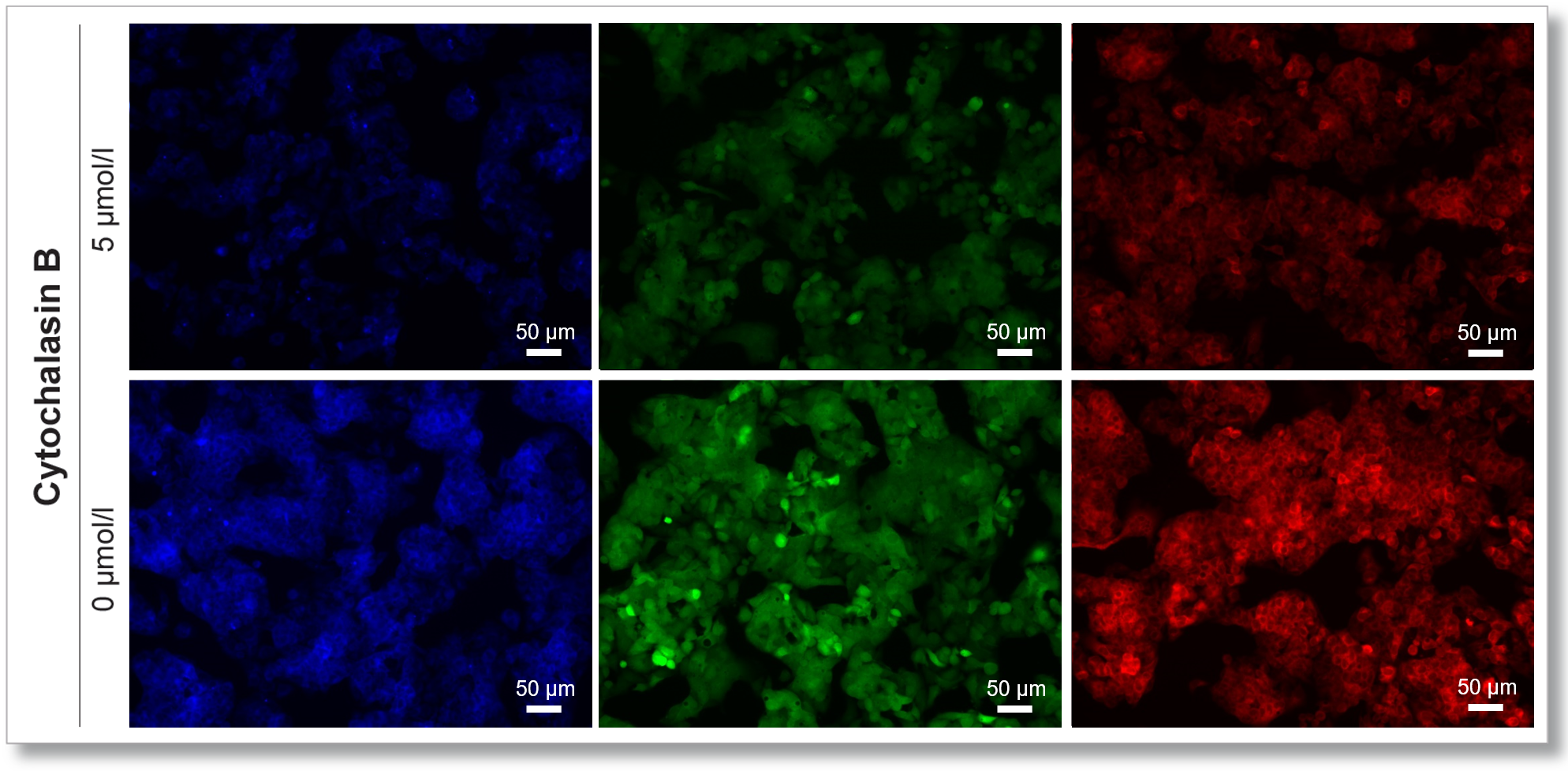
(Scale bar: 50 μm)
<Experimental Conditions>
Cell Line: HepG2
Miedum: MEM (5.5 mmol/l Glucose)
Incubation Conditions: 5 µmol/l Cytochalasin B / MEM (5.5 mmol/l Glucose, 10% FBS), 37℃, 24 hr
Reagent Conditions: Glucose Uptake Probe (500x dilution)/DMEM (0 mol/l Glucose), 37℃, 15 min
Device: Fluorescent Microscopy
Glucose Uptake Assay Kit-Blue: Ex=340-380 nm, Em: 435-485 nm
Glucose Uptake Assay Kit-Green: Ex=450-490 nm, Em: 500-550 nm
Glucose Uptake Assay Kit-Red: Ex=533-557 nm, Em: 570-640 nm
Experimental Example: Enhanced Glucose Uptake by Insulin
Using Glucose Uptake Probe to evaluate insulin-induced glucose uptake enhancing in adipocytes with high sensitivity.
Imaging with microscopy


(Scale bar: 50 µm)
<Experimental Conditions>
Cell: mouse adipocyte
Miedum: DMEM (5.5 mmol/l Glucose, 10% FBS)
Inducer Conditions:0 or 1 µmol/l Insulin / DMEM (0 mmol/l Glucose , serum-free), 37℃, 15 min
Reagent Conditions:Glucose Uptake Probe (500x dilution) /DMEM (0 mmol/l Glucose, serum-free), 37℃, 15 min
Device: Fluorescent Microscopy
Glucose Uptake Assay Kit-Blue: Ex=340-380 nm, Em: 435-485 nm
Glucose Uptake Assay Kit-Green: Ex=450-490 nm, Em: 500-550 nm
Glucose Uptake Assay Kit-Red: Ex=533-557 nm, Em: 570-640 nm
Please refer to the link below for details regarding Insulin treatment.

Difference from Glucose Assay Kit
The difference between Glucose Uptake Assay Kit and Glucose Assay Kit-WST(Code: G264)
1. Glucose Assay Kit-WST can quantify the glucose concentration in cell supernatants.
Glucose Uptake Assay Kit does not apply for the quantification of glucose.
2. Glucose Uptake Assay Kit can evaluate cellular glucose uptake capability in a short time.
Glucose Assay Kit-WST can not measure the glucose level changes in a short period of time.
For more details, please refer to the page of Glucose Uptake Assay Kit-Green (Code: UP02).
Q & A
-
Q
Does Glucose Uptake Probe-Red have selectivity for the type of glucose transporter?
-
A
No. Glucose Uptake Probe-Red is thought to be taken up by cells via multiple glucose transporters. However, there are no detailed data on the selectivity and affinity of this probe for glucose transporters.
-
Q
Which cell lines have been analysed with this kit?
-
A
We have tested the kit in the following cell lines.
Cell lines Human alveolar basal epithelial adenocarcinoma cells A549 Human hepatoma-derived cells HepG2 Progenitor adipocytes Preadipocytes (3T3-L1) Adipocytes Adipocytes (3T3-L1) Lewis lung cancer-derived cells 3LL T cells CD4+ T cell
-
Q
Which inhibitor or experiments altering cellular uptake capacity have been tested with this kit?
-
A
Cell line Dilution factor of probe stock solution staining time (min) Examples Human alveolar basal epithelial adenocarcinoma cells A549 x 500 15 Phloretin, WZB117 Human hepatoma-derived cells HepG2 x 500 15 Cytochalasin B Preadipocytes preadipocyte(3T3-L1) x 500 15 Differentiation to adipocytes Adipocytes adipocyte(3T3-L1) x 500 15 Insulin Lewis lung cancer-derived cells 3LL x 50,000 15 A drug inhibiting glycolysis T cell CD4+ T cell x 500, x5,000 15 Deficiency of glycolytic enzymes
-
Q
What should I do if competitive inhibition of cellular probe uptake by glucose is not possible?
-
A
Competitive inhibition may not occur depending on the expression level and type of glucose transporter in each cell. (Example: HepG2 cells).

In such cases, pretreatment with 2-deoxyglucose (2-DG) may provide a difference in glucose competitive inhibition.
Please refer to the example using the Glucose Uptake Assay Kit-Green (product code: UP02).Inhibition of the Probe uptake by 2-DG pretreatment and glucose competitive inhibition (HepG2 cells)
1. Cells were seeded in dishes or microplates and cultured overnight in a 5% CO2 incubator (37°C).
2. After removal of Medium [DMEM (10% FBS, High-glucose)], 50 mmol/l 2-DG/Medium was added and
cells were incubated in a 5% CO2 incubator (37°C) for 2 hours.
3. Wash the cells twice.
4. Pre-warmed DMEM (Glucose-free, serum-free) was added and the cells were incubated in a 5% CO2
incubator (37°C) for 15 min.
5. After the supernatant was removed, pre-warmed probe solution was added and incubated in a 5% CO2
incubator (37°C) for 15 min.
6. After removal of the supernatant, the cells were washed twice with cooled WI Solution (1x).
7. After removal of the supernatant, ice-cold WI Solution (1x) was added and incubated at room temperature
for 5 minutes.
8. After removal of the supernatant, ice-cold WI Solution (1x) was added.
9. Observed under a fluorescence microscope.
-
Q
Is Glucose Uptake Probe-Red degraded or metabolized after uptaking by cells?
-
A
The structure of Glucose Uptake Probe-Red is stable and will not be degraded during any steps of the protocol. The glucose moiety of Glucose Uptake Probe-Blue may undergo phosphorylation by hexokinase due to its structure, but no further metabolism is expected to occur.
-
Q
After Glucose Uptake Probe-Red is uptaken by cells, can the cells be fixed?
-
A
No. Glucose Uptake Probe-Red leaks from cells after fixation.
-
Q
What type of microplate should be used for cell culture?
-
A
Please use a black microplate for cell culture.
-
Q
Is that possible to store the working solution for a long time?
-
A
No, the Probe working solution cannot be stored. The Probe Stock solution can be stored at -20 oC for 1 month.
-
Q
What should I do if the sensitivity of measurement using Glucose Uptake Probe-Red is low?
-
A
Please consider the probe concentration (×250 to ×1,000) and staining time (15 minutes to 1 hour) as initial considerations.
-
Q
What should I do if the fluorescence background is high in the measurement using Glucose Uptake Probe-Red?
-
A
There is a possibility that some of the probes were not taken up by the cells remained. Please wash the cells again with WI solution.
-
Q
How long is the probe retained in the cells after washing with WI Solution?
-
A
The Probe is retained in the cells for about 1 hour at room temperature in WI Solution. Please note that the retention time may vary depending on the cell type.
-
Q
Can the Glucose Uptake Assay Kit-Red be used to quantify glucose in the culture medium or in cells?
-
A
No, please use our product Glucose Assay Kit-WST (product code G264).
-
Q
Is it possible to quantify Glucose Uptake Probe taken up into cells?
-
A
No, this kit measures the fluorescence intensity of the probe taken up into the cell as an indication of the glucose uptake capacity of the cell.
Handling and storage condition
| 0-5°C |








